The Anatomy of 16-Bit Castlevania: Phase One | Super Castlevania IV
Once you pass through the castle gates, you really get a sense of what Konami was trying to bring to the table with Castlevania on this newer, more powerful hardware. You don’t immediately face a threat upon reaching the castle grounds, but everything seems… livelier. A rousing new musical theme kicks in—you’ll encounter new melodies in every stage, and sometimes multiple times within a stage—and the castle transforms to “greet” the would-be hero. The spiked iron gate rises in the background layer, as if it were some kind of inverted portcullis, slamming into place once it fills the screen and creates a prison-like sense of encagement. Once the spikes lock into place, vines of ivy creep up over them.
A screen into this section, you encounter your first enemy, standing at the top of a short staircase: A skeleton, which occasionally chucks bits of itself your way. It’s slow and almost no threat, and it explodes into a shower of bones when struck.
Shortly beyond the skeleton, Simon drops down onto the grass of the courtyard and encounters something new: An insurmountable chasm. The door in the iron gate suddenly makes the purpose of the massive fence clear. Castlevania IV takes a cue from Super Mario World and uses the Super NES’s graphical layers feature to create a 3D effect within the 2D world, dividing this area into the foreground and the background with the fence as your parrier.
Between the door and pit, there’s no question about you need to do here.
Duck through the door into the background.
This is a neat effect, but like a lot of things in Castlevania IV it doesn’t have much place in the overall game. The entirety of this adventure has a crazy grab-bag feel to it, throwing one new idea at the player after the other and rarely pausing to reprise its most wild concepts. Layering is the first of many gimmicks that fails to play a major role throughout the game.
While this doesn’t exactly fit the rules of sound game design in the traditional “introduce and iterate” sense, it does make for a varied and constantly surprising adventure.
You can fight monsters in the background—besides skeletons, you have bats flying in their usual parabolic arcs as well. The closer you get to the end of this sequence, the thicker the ivy growing on the fence becomes, obscuring the action and making the bats a little harder to spot before they come close… though Simon can simply hold out his whip to defend himself; it dangles in front of him, creating a barrier that projectiles and weak enemies like bats explode against.
In an interesting choice, you move back and forth between layers before ending this sequence in the background rather than the foreground—
—yet emerge into the next area, an interior space, in the foreground.
Each segment (designated as “blocks”) of this stage introduces new enemies and increases the threat level over the area that precedes it. Here, you encounter Bone Pillars, those classic stacks of dragon skulls that spit flame in alternate directions. In the original Castlevania, these didn’t appear until late in stage two; here, they appear in the second portion of stage one.
This doesn’t mean Castlevania IV is aiming to be a more difficult game than the original, though. (If it does, the game fails miserably.) Rather, it’s creating context for greater creative divergence later in the game. By introducing familiar Castlevania concepts early on, the game establishes its world as belonging to the franchise—which allows it to be decidedly Castlevania while throwing out all kinds of interesting innovations at the same time.
The game allows you to upgrade your special weapon from the dagger to the boomerang in this area. That seems pretty handy, but honestly special weapons turn out to be considerably less useful in Super Castlevania IV than in previous games. Even the miserable dagger had some value in Castlevania; here, however, weapons prove to be extremely situational in nature. Thanks to Simon’s increased versatility as a warrior, his standard attacks largely achieve the feats you formerly needed subweapons for.
He has greater reach relative to the boundaries of the screen thanks to his huge sprite proportions; his fully-powered whip now covers 2/3 of the distance between his body and the edge of the screen, greatly reducing the value of the dagger and boomerang. Simon can whip in eight directions, which means the axe—formerly essential for hitting things at an angle—has far less utility. Even the holy water, which was handy for creating an obstructive barrier, is largely mooted by the fact that Simon can hold out his whip to block projectiles.
But, hey, boomerang.
Once you climb up to the higher tier of this block of the stage, you find a series of uneven platforms that require some mild jumping to get past. There’s also a strange, bat-like object here which stands out from the rest of the background. If you attempt to whip it, treating it as an enemy or hazard, Simon will latch onto it with his whip and swing like he was auditioning for Bionic Commando or something. This action is completely useless in this spot…
…but you need to figure it out a short distance ahead, where the grappling bat-hook is your only means for traversing a large gap. You can’t duck into the background here, so there’s nothing to be done for it but swing.
The second mandatory grapple is more difficult, as you swing only to face a Bone Pillar immediately upon landing. While it gives you time to land before belching flame—the swing mechanic here is extremely limited in nature, so it’s not like you can really do anything besides grapple and release—you need to be quick on your feet to avoid being hit and knocked back into the opening you’ve just cleared.
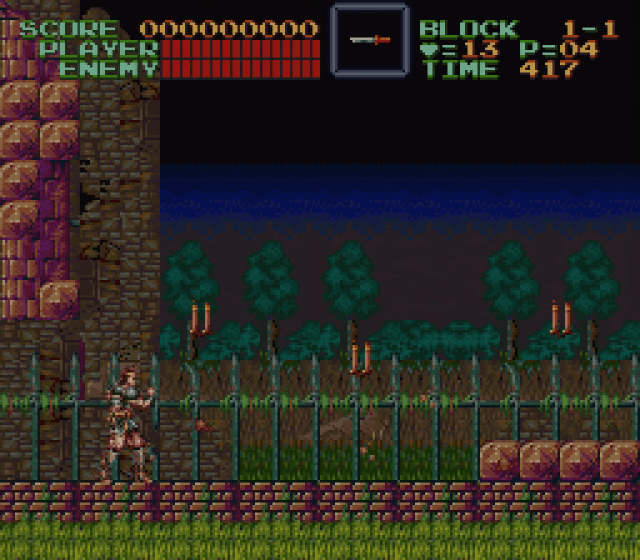
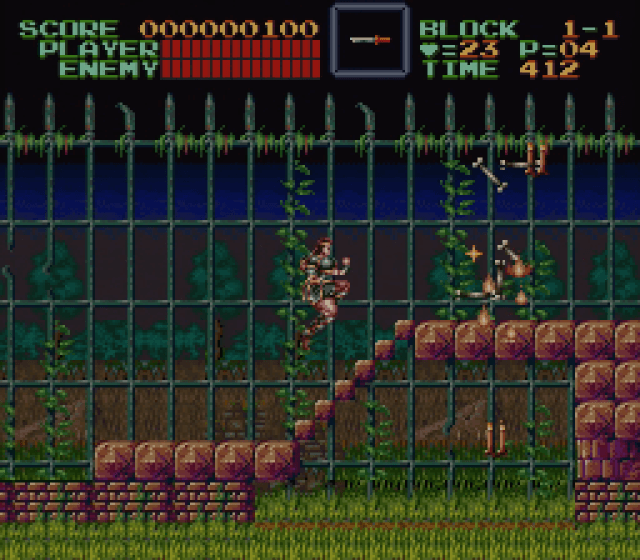
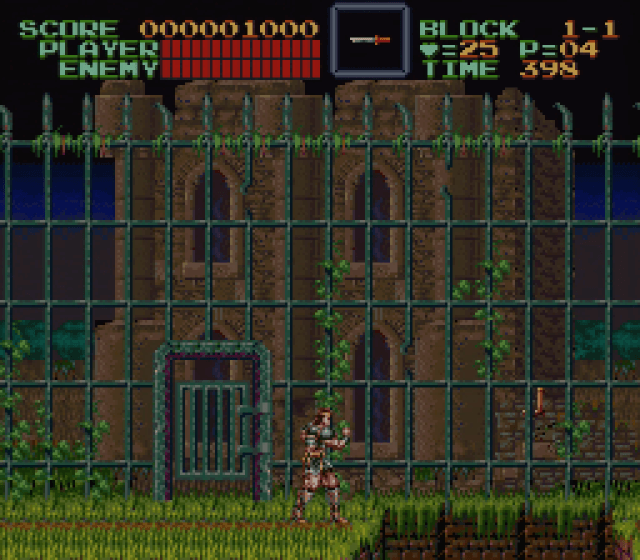
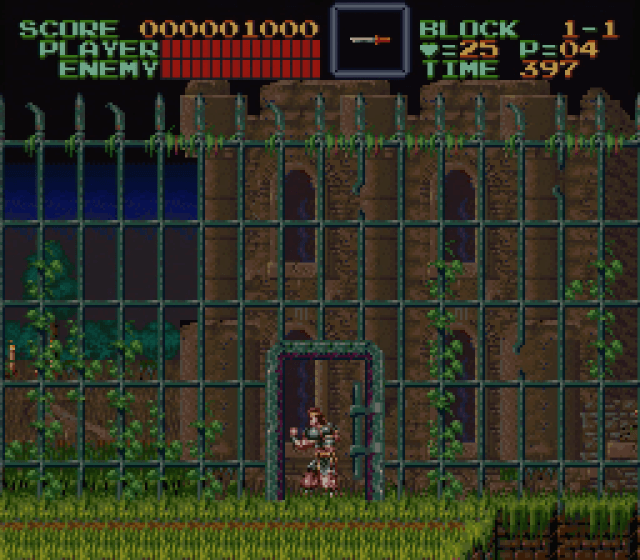
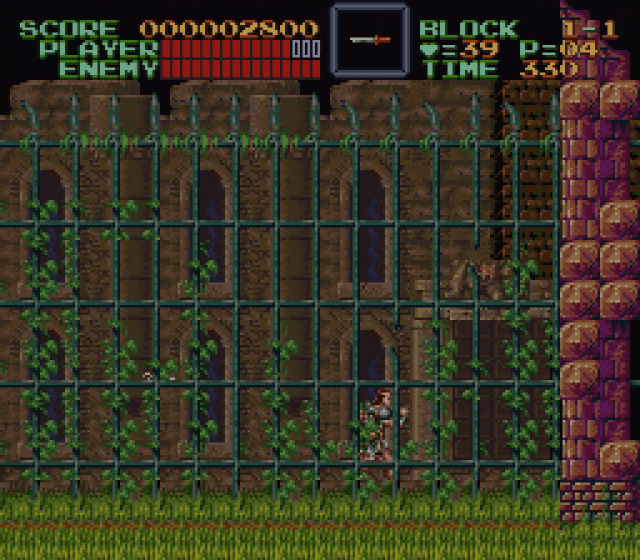
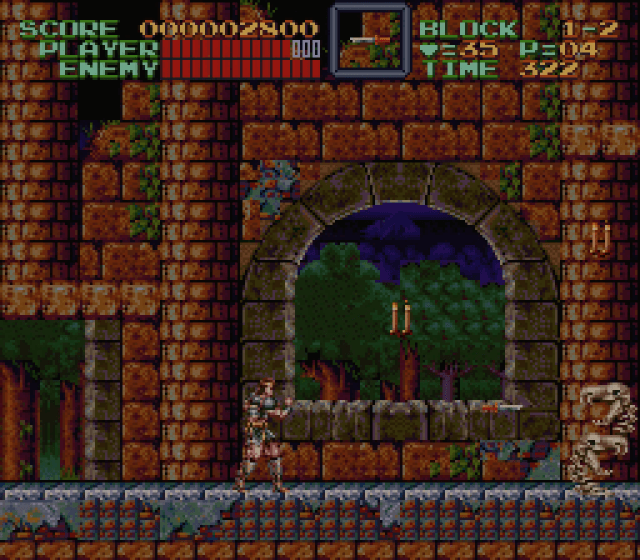


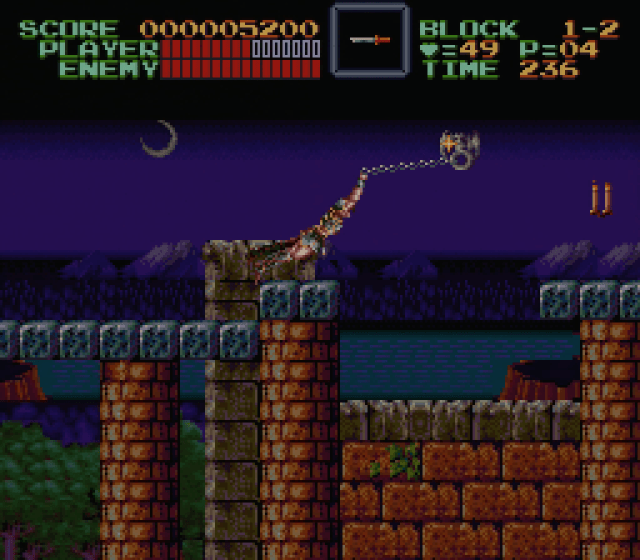

Early SNES games did so many fun things just because they could. Not all of them worked out - some Mode 7 tricks were more distracting than mechanically interesting, and so on. But you really get a sense of programmers and designers just delighting in all the new things they could pull off after graduating from the restrictions of 8-bit hardware, and often that delight is contagious.
The cross remains useful enough for piling damage onto bosses that it still stings when you accidentally switch it out for the knife. The triple cross in particular can cut through many bosses in seconds.
That said, I can think of at least one ostensibly fearsome boss that can be neutered simply by wiggling the whip around in the air, which is as hilarious as it is effective.
The dagger is a universal disgrace!
“the swing mechanic here is extremely limited in nature, so it’s not like you can really do anything besides grapple and release”
You can throw a sub weapon while swinging (making good use of the new R button). This incidentally is also about the only time the knife and axe have some added value. That Bone Pillar in the last picture is just begging for a knife to be thrown at it. As with a lot of new features in CVIV this ability is kinda undercooked, but it’s there nonetheless.
I actually did not know that was possible.
To be fair, I don’t think they bothered to actually mention that in the manual. It’s one of those things you find out by accident.
On some level, I appreciate the “surprise the player with a constant stream of new stuff” approach to design. But incorporating the iteration of core mechanics makes it an even better experience. I think that is something missing from the iterative approach many newer designers employ in classic styled games. They are just missing the surprises because they are too focused on sharpening the player’s need to master the core mechanics by using a very small set of tools. This is why games like Gunstar Heroes are so revered. The diversity is astounding. In Castlevania, Dracula X did a much better job of integrating surprises and iterative mechanics, IMO.
I’ll be honest: I think I’d enjoy further non-Metroidvania style Castlevanias more with whip options like this and no special weapons than a limited whip and useful special weapons.
That might just be me, though.
I never thought about the design of the whip-hooks, but it makes a lot of sense for them to be shaped like enemies. Since the game does not have a little fairy keying you in to every mechanic, it’s up to you to figure out how the swinging works, and even the least observant player is likely to try to attack something that looks like a bat. IIRC, the hooks actually animate, flapping their wings a bit, right?